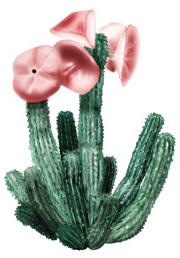Drug patent: San people make claim on Hoodia Gordonii
3/12/01
The San people who are indigenous to Southern Africa are demanding compensation for a drug company's exploitation of their ancient knowledge. They have traditionally eaten slices of the Hoodia cactus in order to stave off hunger on long hunting trips. The plant is now being tested to provide ingredients for an anti-obesity drug by Phytopharm, a British pharmaceutical company. The product could become a best seller in developed countries.
The active ingredient in the Hoodia cactus which acts as an appetite suppressant was identified by the Council for Scientific and Industrial Research in South Africa (CSIR). They passed on their work to Phytopharm, a British pharmaceutical company, who patented it as P57. Phytopharm announced that they had found a possible cure for obesity, without the side-effects of other drugs, because the active ingredient occurred naturally. Their share value rose immediately, and they soon sold the rights to license the drug to Pfizer, the US pharmaceutical giant.

The Working Group of Indigenous Minorities in South Africa, (WIMSA), was set up by the San and Kung groups of indigenous peoples of Southern Africa, to protect their rights and interests. Roger Chennells, a South African lawyer, acts as a consultant to WIMSA and the San. He said, "They are very concerned. It feels like somebody has stolen the family silver and is making a huge profit out of it. The bushmen do not object to anybody using their knowledge to produce a medicine, but they would like the drug companies to have spoken to them first and come to an agreement."
Phytopharm's chief executive, Richard Dixey said that he believed that the people who had discovered the cactus had disappeared, and the man in charge of the CSIR project, Dr Marthinus Horak claimed that there were only a few hundred bushmen left in South Africa, and that they were very hard to contact.